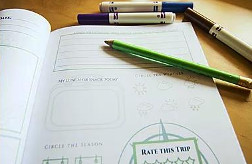Field trips are a great idea, but sometimes we have trouble making sure our children actually learn something. Laena West’s Field Trip Journals help to solve that problem.
Field Trip Journals are available at four levels:
- Adventurer Level for grades PreK-1
- Explorer Level for grades 1-4
- Navigator Level for grades 3-7
- Voyager Level for grades 7-12
Each journal has the same general layout. There are two introductory pages followed by 24, two-page spreads for recording information and reflections on 24 field trips. At the back of each book are two pages for reflecting on the entire year’s worth of field trips. There are also an “Explorer Check List” with a check-off list of items to bring along on field trips and a “Field Trip Word Wall” with challenging words students might want to use as they write. While pages in the journals are tailored to suit the different grade levels, all Field Trip Journals have the same “Field Trip Word Wall.”
Field Trip Journals can be used for all types of field trips. While they are light enough to carry along in a daypack, I expect that it will be most efficient to work in the journals after the field trips rather than during them. However, older children need to know in advance what type of information they will need for their journal, information such as the docent’s name or career requirements that would probably require discussion with the docent.
The two-page spreads for each field trip all have lines for the title of the field trip and its location, a space for drawing something in relation to the field trip, and a box with stars for rating the field trip.
Other features vary by level. For example, the Adventurer and Explorer Levels include space for children to write or draw about lunch, often a highlight for young children. They also have images that they can circle to identify the weather that day.
Explorer and Navigator Levels have an image with a blank word bubble headed, “I kept thinking….” Explorer and Voyager Levels have boxes that help students make connections with books they have read. Navigator and Voyager Levels have spaces for information on the docent. The Voyager Level takes field trip reflection to a higher level with other activities such as questions about the docent’s job as a potential career as well as connecting the field trip historically or geographically, globally (through trade, history, or personnel), and academically (with ties to school subjects).
The total amount of space remains the same from level to level, so even high school students will not need to write very much. They might record words or phrases in some spaces rather than sentences or paragraphs. Each journal has eight blank pages for other notes and doodles, so there is space for overflow if needed.
Grade levels for each journal are approximations. You can easily use any of the journals for a broader grade level span. For example, you could use the Explorer Level with young children by asking questions and taking dictation. Students need to fill in every section for every field trip, and you might adapt sections to better suit a particular field trip.
All books feature three-color printing with the exception of a full-color world map in the introductory pages. The graphic-organizer layout of the pages makes the task of recording field trip information and observations much more manageable for students than if you were to have them write reports on their own.








